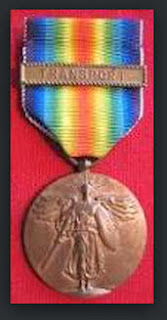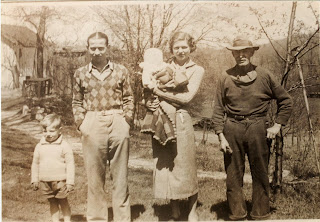On this Veteran’s Day 2013, I am
thinking about my grandfather, Albert Herman Pastoor who served during World
War I in the U.S. Navy. Sadly, I never got the chance to meet him; he died long
before I was born.
Albert H. Pastoor was born on
January 30, 1898, in South Brooklyn, New York, the third child of his German
immigrant parents, Albert and Anna (Kolb) Pastoor. The family was not wealthy, as
evidenced by their moving frequently from one tenement house to another. As a
cook, Albert senior probably did not make much money. Since he worked in the
transportation business, it seems likely he worked along the Brooklyn docks,
maybe working in a kitchen to help feed the longshoremen. My grandfather had two
siblings who died in early childhood. A sister died just months after his
mother gave birth to another sister, and a brother died as an infant from
pneumonia. I imagine the living conditions were crowded and unhealthy and life
at home was a struggle.

In contrast, during the time he
lived there, industry in Brooklyn was booming. Brooklyn was one of the nation’s
leading producers of manufactured goods. It also had sugar refineries which
produced more than half the nation’s sugar. The Williamsburg Bridge, the world’s
largest suspension bridge at the time, was built, as was the city’s first
subway, and Ebbets Field, the home of the Brooklyn Dodgers. Work was plentiful,
but it wasn’t always safe or healthy. Chances are good that Albert worked at
odd jobs when a boy to help make ends meet at home.
When Albert was ten years old,
his father became so gravely ill that he was sent away to a state hospital,
never to come home again, and died three years later. Shortly after, his mother
started to display signs of illness, eventually dying when Albert was 16 years
old.
From a young age, my grandfather’s
parents were negligent or absent, not from choice, but because of poverty, sickness
and death. Between the ages of 10 and 16, Albert had to deal with both parents
being ill and probably struggled to make ends meet, especially after his father
fell sick and could not work. I imagine my young grandfather roaming the
streets of South Brooklyn and winding up on the waterfront. By the time he
joined the Navy, he had numerous tattoos. I imagine tough streets and wonder if
he knew Al Capone, who lived there at the same time as my grandfather. I wonder
if Albert watched the freighters sail into the busiest freight port in the world
or stood looking at the Statue of Liberty across the Bay. I wonder if he ever
visited the U.S. Navy Yard, where the USS Arizona
was being built, or if he ever crossed the Brooklyn Bridge.
In 1915, Woodrow Wilson was
president and Europe was engaged in World War I. Earlier that year, the
Lusitania was sunk by the Germans. By that time, Albert was 17 years old and
living with his married sister in Annapolis, Maryland, and it was there that
Helen signed his consent to join the U.S. Navy. When the United States became
involved in the war in April 1917, Albert was a seaman serving aboard the
battleship USS Texas.
 |
| Victory Medal w/Transport Clasp |
On December 6, 1917, my
grandfather was in Halifax, Nova Scotia, aboard the USS Old Colony which was dry docked for boiler repairs. That was the day two ships collided near
Halifax harbor. One of them, a French freighter, the SS Mont-Blanc, was carrying wartime explosives. Shortly after the
collision, a fire broke out on the Mont-Blanc
causing a “cataclysmic explosion” that was deemed to be the largest man-made
explosion prior to the development of nuclear weapons. The USS Old Colony had received little damage
and was converted to a hospital ship to care for the estimated 9000
wounded. My grandfather received a
commendation for his work during the Halifax disaster.
Albert also served aboard the
USS Wachusetts, a cargo ship sailing
to Brest, France, to bring supplies to the US Army in 1918. For his service aboard both the USS Old Colony and the USS Wachusetts, Albert Herman Pastoor was
awarded the Victory Medal and Transport Clasp.
My grandfather reenlisted two
more times, serving out the rest of his military career at the Naval
Ammunitions Depot on Iona Island, New York. He was honorably discharged on December
17, 1922 with a rank of Boatswain's Mate Second Class.
He left a legacy of which he could
be proud. All three of his sons joined the military, his oldest serving during WWII.
Of his three grandsons, two have made
careers in the military, both serving during peace and wartime.
So this Veterans’ Day, I salute
and honor my grandfather, Albert Herman Pastoor. I don’t know much about him,
but what I do know makes me proud to be his granddaughter.
Bibliography
Compiled service record, Albert H. Pastoor
personnel file, service no. 1521327, (discharged 1921); Official Military
Personnel Files, World War I; Enlisted Personnel, 1885 - 1951, United States
Navy; National Personnel Records Center, St. Louis; photocopies supplied by
Center without citation.
Ebay. US WWI Victory medal with
"TRANSPORT" clasp. http://www.ebay.co.uk/itm/EXC-US-WWI-Victory-medal-with-TRANSPORT-clasp-hand-engraved-rim-/111032568835
: accessed 10 Nov 2013
Reilly, Michael. Life in Brooklyn: 150
years in History. http://www.oocities.org/thereillyfamily/history.htm :
2006.
Thirteen
WNET New York Public Media. History of Brooklyn - Early 20th Century.
http://www.thirteen.org/brooklyn/history/history4.html : 2012.
Time: Disasters that Shook the World. New York City: Time Home Entertainment. 2012.
p. 56.
New York. City of New York. Death
Certificates. New York City Municipal Archives, New York City.
New York. Kings. 1900 U.S. census,
population schedule. Digital images. Ancestry.com.
http://www.ancestry.com : 2004.
New York. Kings. 1905 New York State
Census, population schedule. Digital images. FamilySearch.
http://familysearch.org : n.d.
New York. Kings, Brooklyn. Birth Certificates.
New York City Municipal Archives, New York City.
New York. Kings Park State Hospital. Death
Certificates. Town of Smithtown, Smithtown.











